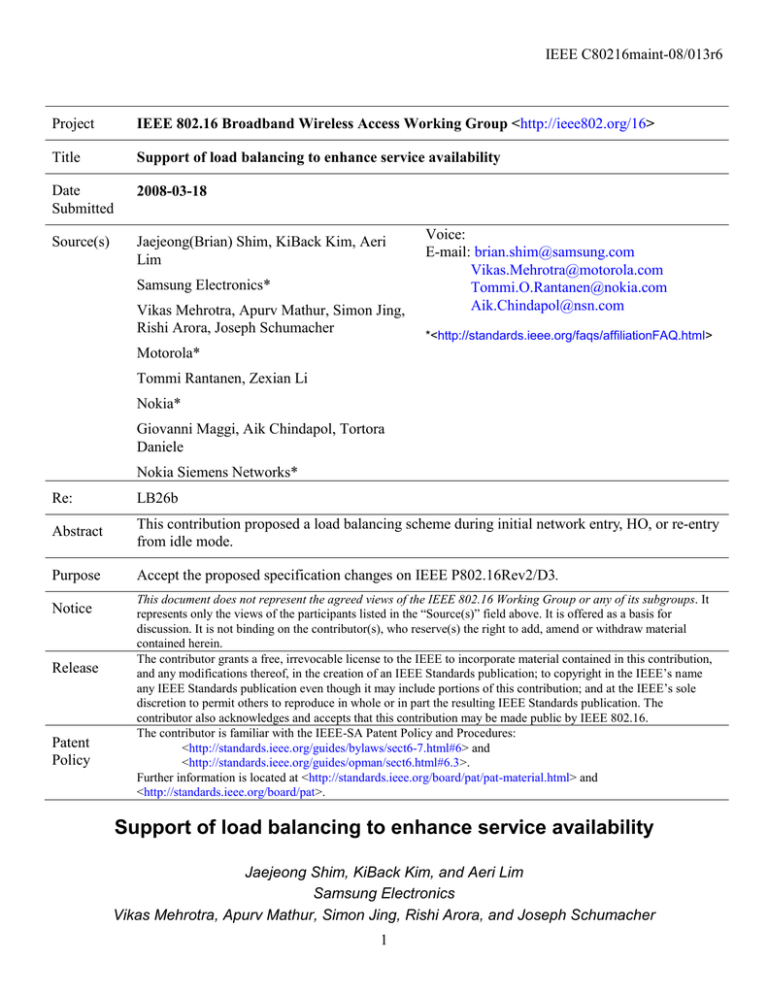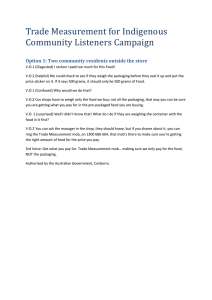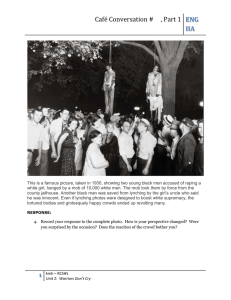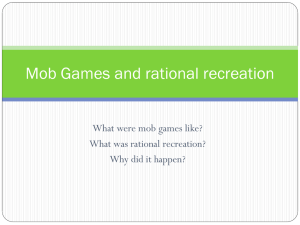IEEE C80216maint-08/013r6 Project Title
advertisement

IEEE C80216maint-08/013r6 Project IEEE 802.16 Broadband Wireless Access Working Group <http://ieee802.org/16> Title Support of load balancing to enhance service availability Date Submitted 2008-03-18 Source(s) Jaejeong(Brian) Shim, KiBack Kim, Aeri Lim Samsung Electronics* Vikas Mehrotra, Apurv Mathur, Simon Jing, Rishi Arora, Joseph Schumacher Voice: E-mail: brian.shim@samsung.com Vikas.Mehrotra@motorola.com Tommi.O.Rantanen@nokia.com Aik.Chindapol@nsn.com *<http://standards.ieee.org/faqs/affiliationFAQ.html> Motorola* Tommi Rantanen, Zexian Li Nokia* Giovanni Maggi, Aik Chindapol, Tortora Daniele Nokia Siemens Networks* Re: LB26b Abstract This contribution proposed a load balancing scheme during initial network entry, HO, or re-entry from idle mode. Purpose Accept the proposed specification changes on IEEE P802.16Rev2/D3. Notice Release Patent Policy This document does not represent the agreed views of the IEEE 802.16 Working Group or any of its subgroups. It represents only the views of the participants listed in the “Source(s)” field above. It is offered as a basis for discussion. It is not binding on the contributor(s), who reserve(s) the right to add, amend or withdraw material contained herein. The contributor grants a free, irrevocable license to the IEEE to incorporate material contained in this contribution, and any modifications thereof, in the creation of an IEEE Standards publication; to copyright in the IEEE’s name any IEEE Standards publication even though it may include portions of this contribution; and at the IEEE’s sole discretion to permit others to reproduce in whole or in part the resulting IEEE Standards publication. The contributor also acknowledges and accepts that this contribution may be made public by IEEE 802.16. The contributor is familiar with the IEEE-SA Patent Policy and Procedures: <http://standards.ieee.org/guides/bylaws/sect6-7.html#6> and <http://standards.ieee.org/guides/opman/sect6.html#6.3>. Further information is located at <http://standards.ieee.org/board/pat/pat-material.html> and <http://standards.ieee.org/board/pat>. Support of load balancing to enhance service availability Jaejeong Shim, KiBack Kim, and Aeri Lim Samsung Electronics Vikas Mehrotra, Apurv Mathur, Simon Jing, Rishi Arora, and Joseph Schumacher 1 IEEE C80216maint-08/013r6 Motorola Inc. Tommi Rantanen, Nokia Giovanni Maggi, Aik Chindapol, Nokia Siemens Networks Problem description When a BS cannot support an MS trying initial network entry, handover, or reentry from idle mode, it has to move the MS to other BS which can support the MS. However, current specification does not support the operation. BS can use RNG-RSP (with ranging status=abort) or DREG-CMD (with action code = 00), but they cannot designate specific target BS to the MS. BS can use the ‘Downlink frequency override’ TLV. But the TLV cannot designate a specific target BS and it is not available when reuse factor = 1. Even though MS can obtain the Service level prediction of each target BS during handover, the system load of target BS may change when the MS moves to the BS. MS could get the loading information (Available DL/UL Radio Resources) in DCD/UCD during network entry. But the information is only for the serving BS. Generally, the TX period of NBR-ADV message is much larger than that of DCD/UCD. Thus, MS may not get the NBR-ADV message during network entry. MS cannot perform load balancing based on the loading information of only the serving BS. In case of re-entry from idlemode, MS may not obtain latest DCD, UCD, and NBR-ADV. The Configuration Change Count of DCD and UCD does not count in the Available DL Radio Resource and Available UL Radio Resource respectively. That means MS mostly have loading information which is not valid any more during re-entry from idle mode. Draft specification [IEEE802.16-Rev2/D2] allows the MS to scan and to initiate at any time handover to target cells different from the ones indicated by the serving BS. Moreover MS can execute handover without even notifying the target BSID to the BS. Such behavior may lead to conflicting decisions between MS and the BS. MS initiated HO primarily aims at individual MS link optimization by taking into account channel quality situation. BS initiated Load Balancing may in general pursue overall network resources optimization by taking into account Serving BS and network load conditions. BS initiated Load Balancing is especially needed in case of high capacity layered networks, when multiple BS service areas overlaps in certain geographical areas. A certain geographical location can be served by a few cells presenting different radio channel conditions (e.g. small/large cells, micro/macro cells). In a similar scenario the MS may regularly tend to affiliate to larger cells since they provide best radio channel conditions, leaving smaller cells unloaded. Even in case of two overlapping cells with identical coverage, carriers might be unequally loaded, since affiliation depends on implementation specific features in the MS such as cell selection and re-selection mechanism. In all of the above cases it is essential to enable BS initiated Load Balancing without incurring in network instabilities caused by ping-pong handover effect. The basic idea is to insert a code for Handover support into DCD in BS to indicate the terminal that the BS supports the capability. So, if the BS supports capability the MS is mandate to perform HO if triggering conditions are met. Because there are three 2 IEEE C80216maint-08/013r6 types of scenario, Normal Handover, Network assisted HO and HO operation mode=1, it has been necessary to repeat the statement three times in different sections. 3 IEEE C80216maint-08/013r6 Proposed Changes Change #1: Add the following TLVs and its description in “RNG-RSP message”: Adopt the following changes in section 6.3.2.3.6 RNG-RSP (ranging response) message: The following parameters may be included in the RNG-RSP message: Timing Adjust Information If this field is not included, no adjustment shall be made Power Adjust Information If this field is not included, no adjustment shall be made Downlink Frequency Override Uplink Channel ID Override Downlink Operational Burst Profile Basic CID A required parameter if the RNG-RSP message is being sent on the Initial Ranging CID in response to a RNG-REQ message that was sent on the Initial Ranging CID. SS MAC Address (48-bit) A required parameter when the CID in the MAC header is the Initial Ranging CID. Frequency Adjust Information AAS Broadcast Permission Preamble Index Override Preamble Index(es) of new target BS(s) where the MS should redo ranging. If the TLV includes two or more Preamble Indexes, the first one in the list is the most preferable and the second is the next preferable. When the TLV is used with Downlink frequency override TLV, the MS should redo ranging on the new DL channel with the Preamble Index(es). Ranging Abort Timer Timer defined by BS to prohibit network entry of an MS for specific time duration. The MS that received the Ranging Abort Timer in RNG-RSP message shall not try network entry to the BS before the timer expires. Change #2: Add the following TLVs in Table 552 - RNG-RSP message encodings: Add the following TLVs into Table 552: Table 552—RNG-RSP message encodings Name Preamble Index Override Ranging Abort Timer Type (1 byte) 39 40 Length Value Length is defined as: (Num of Preamble Index) * 1 1 Preamble Index(es) of new target BS(s) where the MS should redo ranging. PHY scope All If this TLV is used, the Ranging Status value shall be set to 2. This TLV shall be used for licensed bands only. 0-255: In units of seconds All 4 IEEE C80216maint-08/013r6 Change #3: Enhancement of Table 544 “DCD channel encoding”: Change the following entry in Table 544 as indicated: Table 544—DCD channel encoding Name HO type support Type (1 byte) 50 Length Value PHY scope 1 Bit 0: HO Bit 1: MDHO Bit 2: FBSS HO Bit 3: BS_Controlled_HO Bit 34–7: Reserved OFDMA Change #4: Rejection of service flow creation 6.3.14.7.1.1 Dynamic service flow creation—SS-initiated Creation of service flows may be initiated by either BS (mandatory capability) or by SS (optional capability). The SS-initiated protocol is illustrated in Figure 111 and described in detail in 6.3.14.9.3.1. A DSA-REQ from an SS contains a QoS parameter set (marked either for admission-only or for admission and activation). BS responds with DSA-RSP indicating acceptance or rejection. In the case when rejection was caused by presence of nonsupported parameter of nonsupported value, specific parameter may be included into DSA-RSP. If the BS rejects a service flow due to absence of sufficient resources to admit the service flow (see Table 574, CC = 3), the BS may initiate procedures to move the SS to a different BS (see 6.3.22). Upon completion of the handover, the MS may resume service flow creation. Change #5: Enhancement of subsection 6.3.22.2.2, HO decision and initiation: Change the subsection 6.3.22.2.2 as indicated: An HO begins with a decision for an MS to HO from a serving BS to a target BS. The decision may originate either at the MS, the serving BS, or on the network. The HO may proceed with a notification through either MOB_MSHO-REQ or MOB_BSHO-REQ messages. If BS_Controlled_HO flag is set to 0 in HO type support field of DCD message, tThe HO notification is recommended, but not required. If BS_Controlled_HO flag is set to 1, the HO notification is mandatory unless a drop has been detected by MS as specified in 6.3.22.2.6. The MS shall send MOB_MSHO-REQ only if a triggering condition specified in Trigger TLV or Neighbor BS Trigger TLV has occurred. Acknowledgement of MOB_MSHO-REQ with MOB_BSHO-RSP is required. After MS transmits MOB_MSHO-REQ, MS shall not transmit any MOB_MSHO-REQ prior to expiration of timer MS_handover_retransmission_timer. MS shall deactivate timer MS HO retransmission timer on MS transmission of MOB_HO-IND or MS receipt of MOB_BSHO-RSP. If an MS that transmitted a MOB_MSHO-REQ message detects an incoming MOB_BSHO-REQ message before the MS_handover_retransmission_timer (see 11.7.13.3) expires, it shall ignore that MOB_BSHOREQ message. A BS that transmitted a MOB_BSHO-REQ message and detects an incoming MOB_MSHOREQ message from the same MS shall ignore its MOB_BSHO- 5 IEEE C80216maint-08/013r6 REQ. A BS that transmitted a MOB_BSHOREQ message and detects an incoming MOB_HO-IND message from the same MS shall ignore its own previous request. While a handover is in progress, an MS that has transmitted a MOB_HO-IND message and detects an incoming MOB_BSHO-REQ message from the Serving BS shall ignore that MOB_BSHO-REQ. When MOB_MSHO-REQ is sent by an MS, the MS may indicate one or more possible target BS. When MOB_BSHO-REQ is sent by a BS, the BS may indicate one or more possible target BSs. MS may evaluate possible target BS(s) through previously performed scanning and Association activity. Serving BS criteria for recommendation of target BS may include factors such as expected MS performance at potential target BS, BS and network loading conditions, and MS QoS requirements. The serving BS may obtain expected MS performance and BS and network loading conditions at a potential target BS through the exchange of messages with that BS over the backbone network. The serving BS may negotiate location of common time interval where dedicated initial ranging transmission opportunity for the MS will be provided by all potential target BSs. This information may be included into MOB_BSHO-RSP message, and is indicated by Action Time. Dedicated allocation for transmission of RNG-REQ means that channel parameters learned by the MS autonomously, based on information acquired at the time of HO with the target BS or during Association of that BS are considered valid during sufficient time and can be reused for actual network reentry without preceding CDMA ranging. Information such as indicators of link quality in the UL direction learned by the MS during Association may be provided to the serving BS over the backbone. If Network Assisted HO supported flag is set to “1” in MOB_BSHO-REQ message, MS may perform an HO to any BS among the recommended BSs in MOB_BSHO-REQ without notifying the serving BS of a selected target BS. As an acknowledgement to the MOB_BSHO-REQ message, the MS may send a MOB_HO-IND message with its target BSID set to “0x00000000”. When the serving BS, transmitted MOB_BSHO-REQ with Network Assisted HO supported flag = 1, receive MOB_HO-IND with target BS ID = 0x00000000, it may neglect target BS ID included in MOB_HO-IND message. If BS_Controlled_HO flag is set to 0 in HO type support field of DCD message, MS actual pursuit of HO to one of BSs specified in MOB_BSHO-RSP is recommended, but not required. The MS may decide to attempt HO to a different BS that may or may not have been included in MOB_BSHO-RSP. If BS_Controlled_HO flag is set to 1, MS handover to one of BSs specified in MOB_BSHO-RSP is required. An MS may attempt handover to the BS not included in MOB_BSHO-RSP by sending a MOB_HO-IND indicating the selected BS only if a trigger condition specified in a Trigger TLV or Neighbor BS Trigger TLV has occurred for a target BS not listed in the MOB_BSHO-RSP. MS may respond with MOB_HO-IND with HO_IND_type = 0b10 indicating HO reject if MS is unable to handover to any of the recommended BSs in the MOB_BSHO-REQ or MOB_BSHO-RSP. If the MS signals rejection of serving BS instruction to HO through HO_IND_type field in the MOB_HO-IND set value of 0b10 (HO reject option), the BS may reconfigure the neighbor BS list and retransmit MOB_BSHO-RSP message including a new neighbor BS list. In case of BS initiated handover by MOB_BSHO-REQ message, BS may send unsolicited MOB_SCN-RSP with Report mode = 0b10 (Event-triggered report) to trigger MOB_SCN-REP before the transmission of MOB_BSHO-REQ. Based on the scanning results in MOB_SCN-REP, the BS can select a set of recommended BSs and send MOB_BSHO-REQ with the recommended BSs. In some instances, the BS may need to force the MS to conduct HO. The BS shall include a value of HO operation mode = 1 in either the MOB_BSHO-REQ or MOB_BSHO-RSP to signal to the MS that the MS must conduct HO. Upon receiving a message with HO operation mode = 1, the MS should treat the HO request as required and shall respond with an HO-IND. MS should send HO-IND with option HO_IND_type = 0b00 indicating commitment to HO unless MS is unable to HO to any of the recommended BSs in the message, in which case MS may respond with HO-IND with option HO_IND_type = 0b10 indicating HO reject. If BS_Controlled_HO flag is set to 0 in HO type support field of DCD message, aAn MS required to conduct HO is not restricted to conducting HO to those BS included in the notifying message. In other words, the MS may attempt HO to a different BS that may or may not have been included in either the MOB_BSHO-REQ or MOB_BSHO-RSP. If BS_Controlled_HO flag is set to 1 in HO type support field of DCD message, an MS required to conduct handover is restricted to conducting handover to those BS included in the notifying message. Only in case a triggering condition specified in Trigger TLV or Neighbor BS Trigger TLV has occurred for a target BS not listed in MOB_BSHO-REQ or in the MOB_BSHO-RSP, MS may attempt handover to the BS by sending a MOB_HO-IND indicating the selected BS. MS may respond with HO-IND with HO_IND_type = 0b10 indicating HO reject if MS is unable to handover to any of 6 IEEE C80216maint-08/013r6 the recommended BSs in the MOB_BSHO-REQ or MOB_BSHO-RSP. The serving BS may notify one or more potential target BS over the backbone network of MS intent to HO. The serving BS may also send MS information to potential target BS over the backbone network to expedite HO. In order to verify the MS can complete the HO preparation phase in time to receive the Fast_Ranging_IE in the target base station (i.e., after action time), the serving BS may grant an unsolicited UL allocation for transmission of MOB_HO-IND message. In this case, the Unsolicited UL Grant for HO-IND flag in MOB_BSHO-REQ/RSP message serving BS should be set to 1. Upon expiration of Handover Indication Readiness Timer, the serving BS should grant an UL allocation to the MS with a size enough for transmission of MOB_HO-IND message. The serving BS may continue to issue DL and UL allocations to the MS until expiration of Handover Indication Readiness Timer or until MOB_HO-IND with HO_IND_type=0b00 was received or until it received an indication from the target BS (over the backbone network) that MS successfully completed its HO attempt or until it decides that the MS is no longer available. The MS that sent MOB_HO-IND with option HO_IND_type = 0b00 indicating commitment to HO and intent to release the serving BS, shall not be expected to monitor serving BS DL traffic after transmission of the MOB_HO-IND message. 7 IEEE C80216maint-08/013r6 References [IEEE802.16-Rev2/D3] IEEE Computer Society and IEEE Microwave Theory and Techniques Society, “DRAFT Standard for Local and Metropolitan Area Networks Part 16: Air Interface for Broadband Wireless Access Systems”, P802.16Rev2/D3 (February 2008). Revision of IEEE Std 802.16-2004 and consolidates material from IEEE Std 802.16e-2005, IEEE Std 802.16-2004/Cor1-2005, IEEE Std 802.16f-2005 and IEEE Std802.16g-2007. 8








